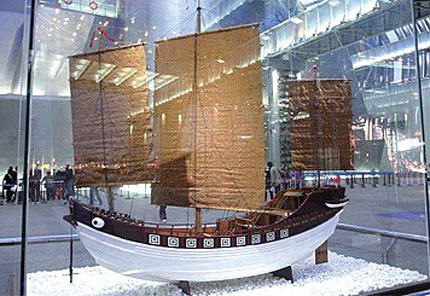
A local craftsman is preserving China's heritage with exhaustively researched copies of ships that once were Shanghai's lifeblood. Qu Zhi climbs aboard.
The ship was a three-masted, 800-ton Fuzhou trading junk that sailed around the Cape of Good Hope and, between 1846 and 1848, became the first Chinese ship to visit New York and London.
The Keying (Qiying耆英号) was celebrated as an advanced and swift design, and was visited by Queen Victoria, showman P.T. Barnum and thousands of people who paid admission to see it.
While the original was secretly purchased by British businessmen, then taken apart and studied, never to leave England, Shanghai craftsman Zhang Yuqi, 58, who lives in Lujiazui of the Pudong New Area, is helping make sure that the Keying still exists in China, albeit in a version 25 times smaller than its namesake.
Zhang closely studied the celebrated ship and painstakingly reconstructed it in teak.
Zhang put his words into action by prompting Pudong government last month to name ship modeling as its newest intangible cultural heritage.
Zhang has been dedicated to Chinese ancient ship modeling for more than 30 years. He had made thousands of sailing ship models of 300 types. Besides Keying, Zhang revived the memory of many classic Chinese ancient ships, while others have been lost to history.
Zhang's efforts have been widely recognized. During the World Expo 2010 in Shanghai, Zhang was invited to show six ancient Chinese ship models at the China State Shipbuilding Corporation Pavilion.
Born in 1955, Zhang was fascinated by sailors when he was a child. Both his great-grandfather and his father worked in the ship-building industry. "I grew up near the Huangpu River and was deeply influenced by my family. My childhood favorite was to watch the different ships sailing on the Huangpu River," he recalls.
By 1972, Zhang was working at a jade-carving factory where he enhanced his skills. Later, he worked at the Shanghai Ship Yard Company. In 2008, Zhang established his own workshop.
Zhang produces models of modern ships, electromechanical models, Western sailing yachts and more. But he is hooked on Chinese ships of the past, which he says they are the "least profitable."
"In 1991, I went to an international sailing ships conference. I saw many ancient Chinese ship models designed and exhibited by foreigners," Zhang says. That made him realize that he had a huge gap in his knowledge of his country's ship-building history.
"At the same time, I felt inexpressibly sad and upset," he adds, since foreign experts seemed to know more about the topic than his countrymen. That convinced him to learn as much as he could.
"For me, authenticity is crucial," he says. Zhang said too many model ships are not based on solid research.
Some artists concentrate on exquisite carvings with Chinese dragons and phoenix, but historical Chinese ships were more practical, he explains. Model makers, he says, need to respect history.
Zhang spends a lot of time observing and studying. He collects many aged books and materials on ship-building history. Some are published abroad and written in English.
"I can't understand a word of it, so I have to ask my daughter to translate for me. And luckily, there are many pictures," he says.
Though Zhang can't speak English, he can paraphrase almost every chapter of the book.
Zhang travels frequently in Zhejiang and Fujian provinces and in the Guangxi Zhuang Autonomous Region to visit locations where some old ships still exist. He photographs them extensively and talks to local sailors.
"Not that professionals and experts lack knowledge - they have accurate description of the structure. But when it comes to the details of the ship, like a tiny components, they may have no idea since none of them has actually sailed the ship or were involved in building it," he says.
